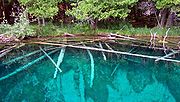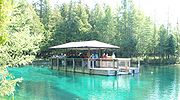
Kitch-iti-kipi
Encyclopedia



Kitch-iti-kipi spring is one of Michigan's Upper Peninsula's major tourist attractions. It is northwest of Manistique about six miles (10 km) west on US Highway 2
U.S. Route 2 in Michigan
US Highway 2 is a component of the United States Numbered Highway System that connects Everett, Washington, to the Upper Peninsula of the US state of Michigan, with a separate segment that runs from Rouses Point, New York, to Houlton, Maine...
and twelve miles (19 km) north on M-149
M-149 (Michigan highway)
M-149 is a north–south state trunkline highway in the Upper Peninsula of the US state of Michigan. It connects US Highway 2 in Thompson with the Palms Book and Indian Lake state parks. The highway was originally designed in the 1930s and extended a few years later...
in Thompson Township of Schoolcraft County
Schoolcraft County, Michigan
-National protected areas:* Hiawatha National Forest * Seney National Wildlife Refuge-Demographics:As of the census of 2000, there were 8,903 people, 3,606 households, and 2,498 families residing in the county. The population density was 8 people per square mile . There were 5,700 housing units...
at the northern terminus. It is located within the Palms Book State Park
Palms Book State Park
Palms Book State Park is a state park in Thompson Township, Schoolcraft County, in the eastern Upper Peninsula of Michigan. Approximately in size, it is noted for Kitch-iti-kipi, the "Big Spring" of the Upper Peninsula...
.
Features
Kitch-iti-kipi is an oval pool measuring 300 feet by 175 feet (90 m × 53 m) and is about 40 feet (12.2 m) deep with an emerald bottom. From the fissures in underlying limestone flows 10,000 gallons per minute (630 litres per second) of spring water throughout the year at a constant temperature of 45 °F (7.2 °C).Hydraulic pressure forces the groundwater to the surface. It is not known exactly where this enormous volume of water comes from. The spring's pool bowl is similar to other sinkhole
Sinkhole
A sinkhole, also known as a sink, shake hole, swallow hole, swallet, doline or cenote, is a natural depression or hole in the Earth's surface caused by karst processes — the chemical dissolution of carbonate rocks or suffosion processes for example in sandstone...
s except it is connected with an aquifer
Aquifer
An aquifer is a wet underground layer of water-bearing permeable rock or unconsolidated materials from which groundwater can be usefully extracted using a water well. The study of water flow in aquifers and the characterization of aquifers is called hydrogeology...
(underground stream) to Indian Lake. The small spring pool was created when the top layer of limestone dissolved away and collapsed into the cave already created by the underground water.
Ancient tree trunks with mineral encrusted branches can be seen, as well as fish that appear to be suspended in the crystal clear waters of the spring. The fish are lake trout
Lake trout
Lake trout is a freshwater char living mainly in lakes in northern North America. Other names for it include mackinaw, lake char , touladi, togue, and grey trout. In Lake Superior, they can also be variously known as siscowet, paperbellies and leans...
, brown trout
Brown trout
The brown trout and the sea trout are fish of the same species....
and brook trout
Brook trout
The brook trout, Salvelinus fontinalis, is a species of fish in the salmon family of order Salmoniformes. In many parts of its range, it is known as the speckled trout or squaretail. A potamodromous population in Lake Superior are known as coaster trout or, simply, as coasters...
. On occasion you will spot yellow perch
Yellow perch
The yellow perch is a species of perch found in the United States and Canada, where it is often referred to by the shortform perch. Yellow perch look similar to the European perch, but are paler and more yellowish, with less red in the fins. They have six to eight dark, vertical bars on their sides...
and other species that move between Big Spring and Indian Lake.
A kaleidoscope
Kaleidoscope
A kaleidoscope is a circle of mirrors containing loose, colored objects such as beads or pebbles and bits of glass. As the viewer looks into one end, light entering the other end creates a colorful pattern, due to the reflection off the mirrors...
effect of ever-changing shapes and forms are caused by the clouds of sand kept in constant motion by the gushing waters that are created by the fast moving waters of Big Spring.
Raft
A self-operated observation raft guides park visitors to vantage points overlooking the underwater features. This raft is on a cable that is pulled across the spring pool by the park visitors. It is often pulled by a park employee. There are viewing windows where the visitors can see the fast flowing spring. One can look over the side of the raft for viewing as well. The spring is crystal clear and is enjoyed from the shore by many visitors. The Civilian Conservation CorpsCivilian Conservation Corps
The Civilian Conservation Corps was a public work relief program that operated from 1933 to 1942 in the United States for unemployed, unmarried men from relief families, ages 18–25. A part of the New Deal of President Franklin D...
constructed the raft, dock, concession stand and ranger's quarters with other groups that participated.
History
The state of Michigan acquired Kitch-iti-kip in 1926. History records that John I. Bellaire, owner of a Manistique Five and Dime store, fell in love with the black hole spring when he discovered it in the thick wilderness of Michigan's Upper Peninsula in the 1920s. It was hidden in a tangle of fallen trees and loggers were using the nearby area as a dump.Bellaire saw its potential as a public recreational spot. He could have purchased the spring and adjoining property himself, however persuaded Frank Palms of the Palms Book Land Company to sell the spring and 90 acres (36.4 ha) to the state of Michigan for $10. The property deed requires the property to be forever used as a public park, bearing the name Palms Book State Park. The State of Michigan has since acquired adjacent land so the park now encompasses over 300 acres (121.4 ha).
Old Indian legends
The following are Indian legends that some say were made up by Bellaire himself to publicize the park.One legend goes that Kitch-iti-kipi was a young chieftain
Chieftain
Chieftain may refer to:The leader or head of a group:* a tribal chief or a village head.* a member of the 'House of chiefs'.* a captain, to which 'chieftain' is etymologically related.* Clan chief, the head of a Scottish clan....
of the area. He told his girlfriend that he loved her far more than the other dark-haired maidens dancing near his birchbark wigwam. She claimed she wanted to put him through a test of love and demanded, "Prove it!" The test of his devotion was that he must set sail in his canoe on this spring lake deep in the conifer swamp. She would then leap from an overhanging branch in an act of faith. He was to catch her from his canoe proving his love. He then took his fragile canoe onto the icy waters of the lake looking for her. Eventually his canoe tipped over in the endeavor. He drowned in the attempt to satisfy the vanity of his love for this Indian maid. It turned out she was back at her village meanwhile with other Indian maidens laughing her head off about his silly quest. The spring was then named in his memory.
Another legend was that they took a drop of honey on a piece of birch bark and dipped it into the spring. This was then presented to a loved one to make them true forever.
Another legend talks about the tamarack trees growing on the banks of the spring. A small piece of the bark was ground in a mortar and pestle
Mortar and pestle
A mortar and pestle is a tool used to crush, grind, and mix solid substances . The pestle is a heavy bat-shaped object, the end of which is used for crushing and grinding. The mortar is a bowl, typically made of hard wood, ceramic or stone...
. The remnants were then placed in an individual's empty pockets and magically would be replaced by glittering gold at exactly midnight that night.
Other Indian legends tell of some Chippewa parents who came to the pool seeking names for their newborn sons or daughters. They supposedly found names like Satu (darling), Kakushika (big eye), Natukoro (lovely flower) and We-shi (little fish) in the sounds of the rippling water. Still other legends say the Chippewa Indians had even attributed special healing powers to the spring waters.
The name Kitch-iti-kipi is said to have many meanings in the Chippewa's language. Some were “The Great Water”, ”The Blue Sky I See”, and “Bubbling Spring”. Other Chippewa Indians called it “The Roaring“, "Drum Water”, and the “Sound of Thunder” - even though there is total silence coming from the spring!

